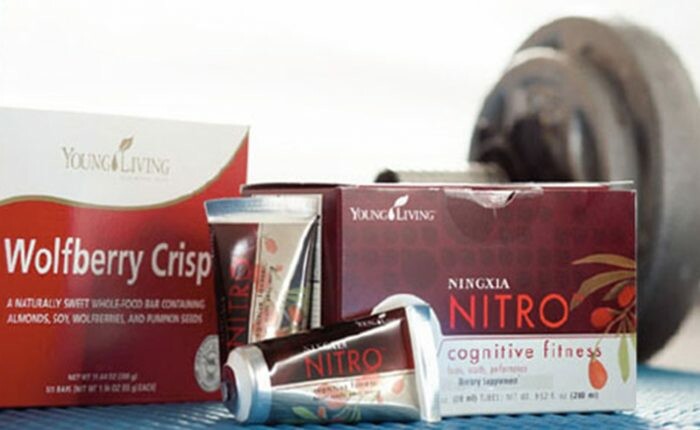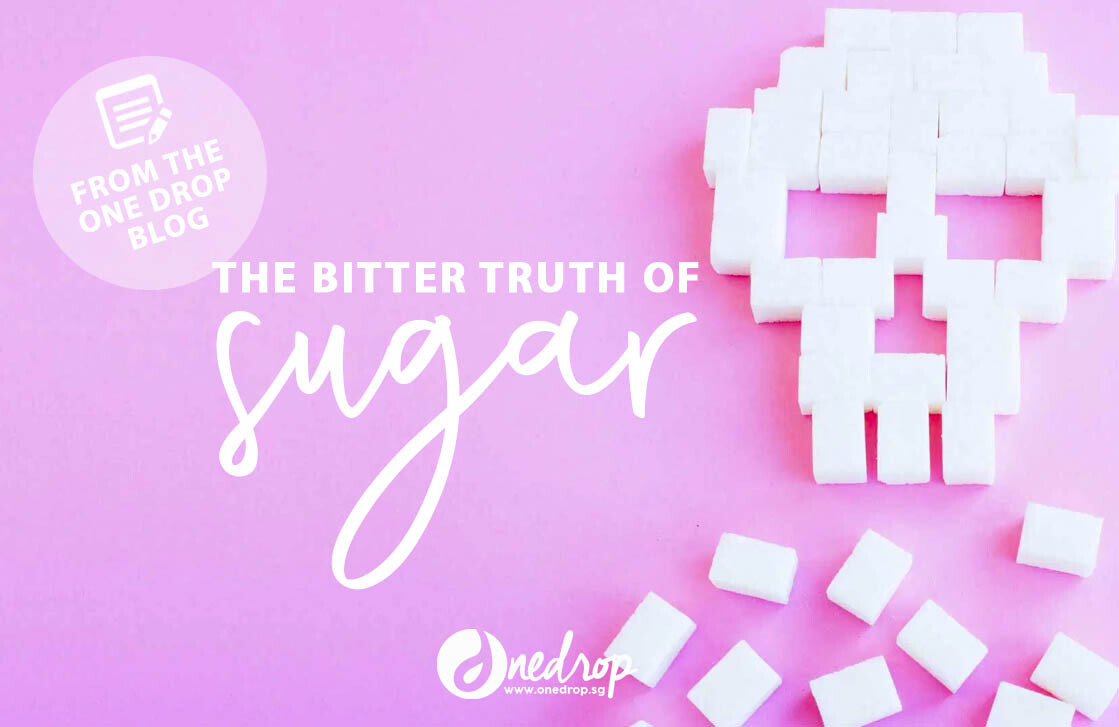
THE BITTER TRUTH OF SUGAR
This post is contributed by One Drop member –Eva Rosdiana.
Dr Robert Lustig’s video in Youtube has reached 11 million views up to today. It is titled “Sugar – The Bitter Truth.” He is a paediatric endocrinologist who presented the biochemistry of how our body processes sugar in University of California, San Francisco. The fact was mind blowing.
Let’s talk about table sugar. In chemistry terms, table sugar is called sucrose -a two-chain carbohydrate that consists of one Glucose molecule and one Fructose molecule. When we consume sucrose, our body breaks it down into Glucose and Fructose very fast. Here is how Glucose and Fructose are processed in liver after being released to our bloodstream.

Summary of the above diagram:
| Glucose | Fructose | |
| In blood and body | 1. 80% goes to bloodstream to become blood glucose. 20% is sent to liver 2. Pancreas then secretes insulin to neutralize blood glucose 3. With help from insulin, glucose is sent to cells and organs, stored in muscle glycogen and fat cells. 4. Fat cells secretes leptin to signal satiety to brain | 1. 100% is sent straight to liver. 2. Only liver can metabolize fructose. Liver will accept any number of fructose even though it’s ‘exhausted’ |
| In liver | 5. Part of 20% glucose is stored into muscle glycogen 6. Another part is metabolized into VLDL and triglyceride | 3. When liver glycogen is filled up, liver will start new fat making process (De Novo Lipogenesis – DNL) 4. Part of fructose causes uric acid and subsequently high blood pressure 5. DNL process results in Non-Alcoholic Fatty liver disease (NAFLD), larger amount of VLDL, Triglyceride (that is glycated and prone to oxidation) 6. Fatty liver impacts insulin resistance, obesity and leptin resistance. |
In 2009, Dr Lustig mentioned that the metabolism of fructose in liver is equivalent to the metabolism of alcohol in liver. Fructose consumption has increased tremendously, especially after the invention of high fructose corn syrup and the campaign of “fats are the causes of heart disease” in 1950. As a result, obesity and many metabolic syndrome diseases such as diabetes type 2, atherosclerosis, cardiovascular disease keep increasing.
However, the bitter truth of sugar, is far beyond that…
Advanced Glycation End (AGE)
Our cells (including skin) are mainly made of amino acids. The amino acids from food is transported in the blood. Liver produces cholesterol, packs it in lipoprotein membranes, transports it to cells for hormone making. Cholesterol aids in inflammation. We cannot live without cholesterol. They are crucial.
AGE is the attachment process of sugar molecule and protein (amino acids) and/or fatty acids. When we have high blood glucose, there is tendency the glucose molecules will bind with amino acids and lipoprotein that are circulating in blood.
Imagine when we do meat barbecue and put some honey onto our meat. The meat will be cooked and browned faster. This happens when our cells or fats meet with sugar. They become ‘glycated’ or caramelized. It results in:
- Premature aging: collagen and cells become hardened and lose their elasticity. Skin becomes saggy, wrinkled, and loses of radiance.
- High level of inflammation. When cholesterol comes in to reduce inflammation, it meets with glucose. Cholesterol is then glycated, oxidized and built up as plaque in artery. So the culprit is sugar and not cholesterol.
Sugar decreases our immunity
Sugar disrupts the work of white blood cells in fighting infection in our body. This picture shows the comparison on the white blood cells – neutrophils and monocytes – performance on normal vs high blood glucose condition. They are very important

Natural sugar: Honey, Fruit Juice, Coconut Sugar, Palm Sugar
Are they better than sugar?
Honey, coconut sugar, palm sugar, contain both glucose and fructose. They are healthier than sugar due to minerals or prebiotics in them which may be beneficial for our gut in the raw and unrefined form.
BUT we still need to eat in moderation, especially if we already have pre-diabetic or high blood glucose conditions.
Honey contains more fructose than glucose and has lower GI. But the metabolism of fructose is burdening the liver.
Even though fruit contains fructose, in its whole form it contains fiber. Fiber slows down the sugar absorption. Juicing destroys the fiber and makes the body absorbs sugar faster. Eating an orange will give you more satiety as compare to drinking orange juice. Plus you use larger amount of fruit when you juice.
Let’s explore healthier sugar substitute.
Sugar Substitute
Artificial sweeteners are never good. Here are some recommended sugar substitutes.
| Recommended | OK in moderation |
· Stevia: Choose in green powder form. Avoid the white ones as they are added with maltodextrin. Read the ingredients · Monk Fruit/Lo Han Guo: The sweetness comes from an antioxidant called mogrosides not fructose. They are often sold as dried fruit. We can boil the fruit in a water and keep in fridge. Consume when needed. | · Erythritol: Erythritol is mainly derived from corn. It contains zero calories and is often used for sugar substitutes. · Xylitol: is a naturally occurring alcohol found in most plant material, including many fruits and vegetables. It is extracted from birch wood to make medicine. Xylitol still contains minor amount of calories. Both erythritol and xylitol are considered sugar alcohol or polyol. Monitor body reaction as they may cause some indigestion like bloating or laxative effect when taken excessively. |
Minimize Sugar intake whenever possible
Try to avoid sugar or at least take in moderation. Always read the ingredients in your food label because sugar can be in any forms. Avoid those ingredients ended with -ose because they are part of sugar.
You will notice how your overall health improve just by reducing / eliminating sugar and all refined and ultra-processed food in few months!
If you like Eva’s articles and would like to purchase the Young Living oils or have further clarifications, you may get in touch with Eva via Facebook or Instagram. If you are ready to sign up as member with Eva, you may click here.
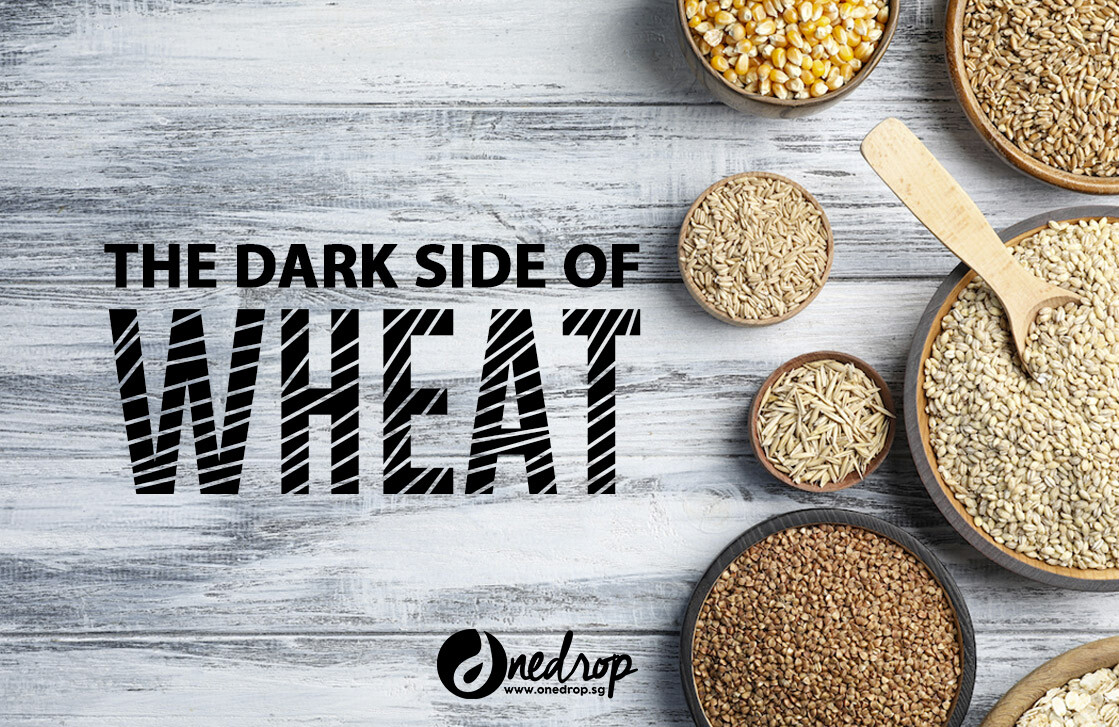
THE DARK SIDE OF WHEAT
This post is contributed by One Drop member –Eva Rosdiana.
Grains, especially wheat is perceived as healthy food. In Asia, “whole-wheat” or “whole-grain” is thought to be better than rice. Health practitioners recommend including grain in our diet, and wheat is among the top choice. In Singapore, food packaging with “Higher in Wholegrain” label has healthier choice logo on packaging.
In 2011, a cardiologist, Dr. William Davis published a book titled: Wheat Belly. 2 years later, a neurologist, Dr. David Perlmutter published another book: Grain Brain. These 2 books explain the danger of high carbohydrate food, particularly wheat and gluten.
Many research shows that gluten disrupts our digestive system. Gluten causes lots of intolerance and even allergies. Yet, Dr. Davis wrote in Wheat Belly that the danger of wheat is far beyond gluten intolerance and allergy.
Modern Wheat is High-GMO
But why did people in the ancient civilisation (like in the bible) seem fine with wheat? It is because the wheat that we eat nowadays is so much different from the ancient wheat.
Anthropologist recorded Einkorn as the first cultivated wheat in human civilisation. It was around 150cm in height, produced small grain, and has low yield. It has a total of 14 chromosomes (7 diploids). Through natural evolution and hybridisation, the ancient wheat evolved to Emmer, Spelt, and Durum wheat.

Every evolution added new chromosomes into the species. The current wheat has undergone a very heavy process of genetic modification. The seeds have gone through radiation to create a species that can produce a much higher yield, bigger grain, and resistant to climate and pest. This genetic modification is one of the main causes why modern wheat can result in intolerance and allergies.
Summary of Einkorn vs Modern Wheat
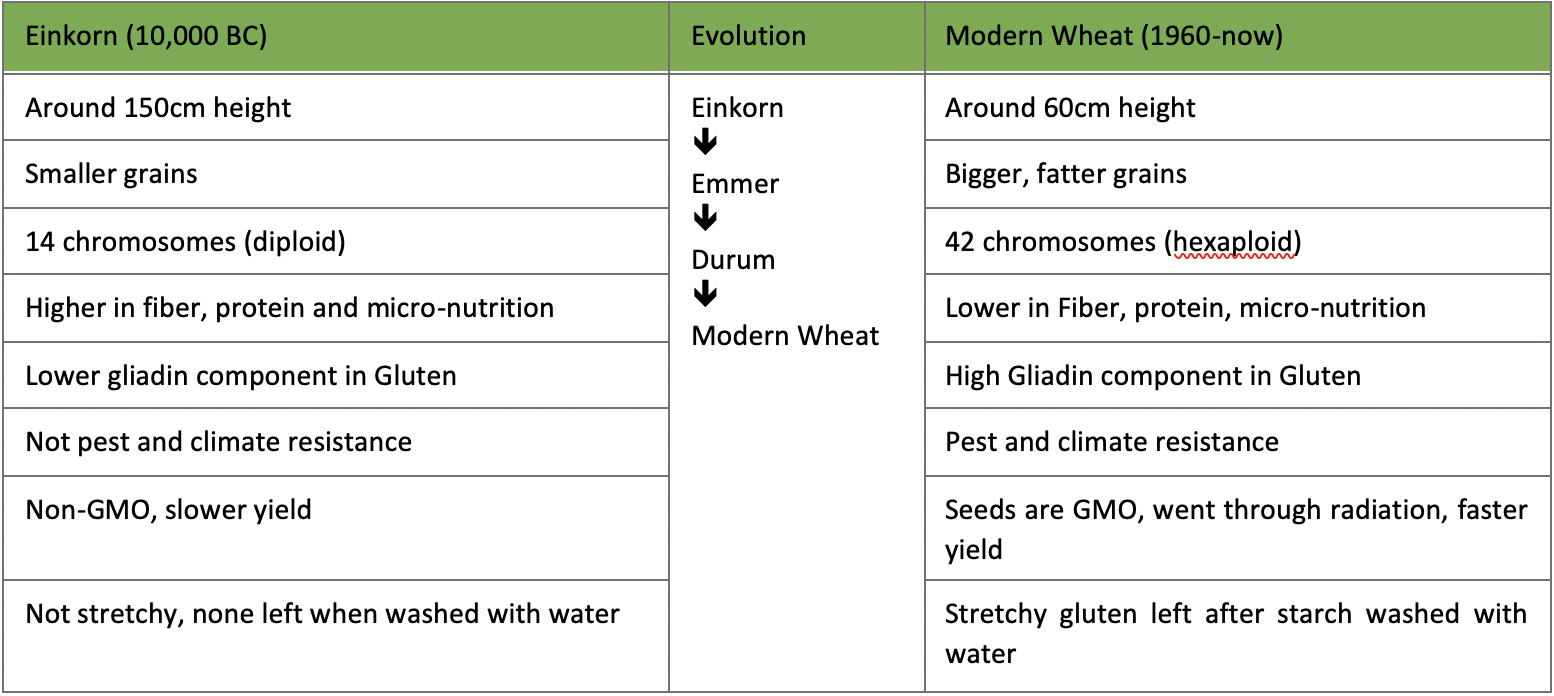
Amylopectin-A
Amylopectin is a branched chain of glucose in high carbohydrate food. Typically, there are 3 types of amylopectin, based on the speed of absorption and insulin spike in our body.
- Amylopectin-A: in Grains.
- Amylopectin-B: in root starchy vegetables such as potato, yam, sweet potato.
- Amylopectin-C: in Legumes.
Amylopectin-A is the highest in glucose and the fastest to break down in our body. Thus, it increases insulin secretion. It causes a high spike in blood glucose, stimulates our appetite, and does not promote high satiety. [Source: Wheat Belly, Dr. William Davis]
Due to the high processing, the current wheat has almost no fiber. As such, it also contributes to the insulin spike and high blood sugar because the glucose molecules are released rapidly into our blood.
Gluten – The indigestible Protein

There are 2 components of gluten: Gliadin and Glutenin (as in the left image). The main problem of gluten lies in Gliadin.
When we eat protein (such as egg, meat), our body breaks down the protein into peptides and subsequently to the smallest part, amino acids. However, our body does not have good enzymes to break down gliadin. Gliadin can only be broken down to peptides and it cannot be absorbed by our gut lining. This is what causes the problem.
Undigested Gliadin Triggers Immune Response

Gliadin weakens Intestinal Wall
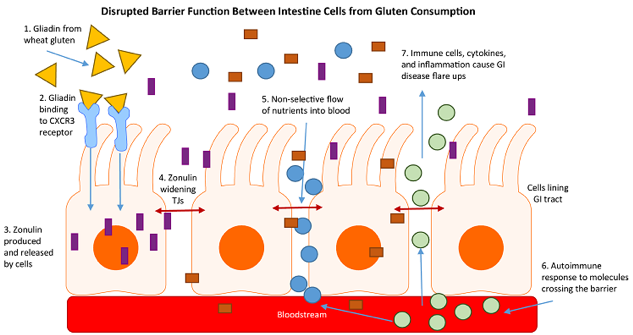
Research has shown that gluten causes changes in gut permeability, also known as loss of gut tight junction barrier function in the GI tract. Normally, cells in the GI tract are spaced at a specific distance from each other. These spaces are known as gut tight junctions (TJs) and need to be spaced close to one another in order to have selective flow of nutrients in and out of the gut.
When gliadin from gluten interacts with the CXCR3 receptors on cells within the GI tract, a protein called zonulin was produced and released by cells. Zonulin then reacts with the GI cells, causing gut tight junctions to grow wider. With the gut TJs widened, molecules that are usually too big to fit through can freely flow in and out of the gut. A research team led by Dr. Maria Barbaro at the University of Bologna in Italy believes that zonulin is a potential biomarker candidate for changes in gut permeability-related GI diseases. [source]
Triggers Brain (Neuro) Inflammation
In Non-Celiac Gluten Sensitivity (NCGS), gluten-triggered inflammation in the gut can instigate inflammation in the brain, referred to as neuroinflammation. Neuroinflammation has been found to play a central, triggering role in brain-related disease. In NCGS, there is a series of steps in the process that ultimately culminates in neuroinflammation and brain changes.
- Consumption of gluten triggers dysbiosis and gut inflammation and increases the permeability of the intestinal barrier.
- Increased intestinal permeability allows lipopolysaccharides (LPSs) produced by gut bacteria to leak out of the intestine and into the systemic circulation. Leaked LPSs trigger the immune system to release pro-inflammatory cytokines.
- LPSs and pro-inflammatory cytokines in the circulation cause toxins to accumulate in the blood stream, inciting systemic inflammation.
- When systemic inflammation reaches the brain, it creates neuroinflammation.
- Neuroinflammation leads to brain dysfunction, cognitive impairment, and an increased vulnerability to neurodegenerative disease.
Neuroinflammation has been associated with depression and anxiety, bipolar disorder, schizophrenia, ADHD, and an increased vulnerability to neurodegenerative diseases. Therefore, NCGS may be an underlying cause of neuroinflammation, gradually altering the normal, healthy functioning of the brain and leading to manifestations of mental health problems and neurological disease. [source]
Going Gluten-Free
The fundamental basis of treatment for non-celiac gluten sensitivity is removal of gluten from the diet. Research indicates that when gluten is removed from the diets of individuals with NCGS, a complete resolution of symptoms may happen.
A nutrient-dense diet that contains plenty colorful vegetables; some fruit; high-quality sources of animal protein; a healthy balance of fats, nuts, and seeds; and perhaps some whole and high-fiber gluten-free grains like brown rice, millet, oats, quinoa is a great framework for a balanced gluten-free diet.
In South East Asia, our traditional diet is mainly gluten-free. Our staple grain is rice and many of our traditional snacks like Nonya kueh are made from rice, glutinous rice flour, tapioca starch. We can always choose those traditional snacks compared to the western cakes and desserts.
Conclusion
Like sugar, the consumption of wheat should be minimised. Wheat mainly contributes to inflammation and discomfort in our digestive system. Minimising wheat consumption will save our intestine from chronic inflammation. Thus, we’re protecting our body health in general.
If you like Eva’s articles and would like to purchase the Young Living oils or have further clarifications, you may get in touch with Eva via Facebook or Instagram. If you are ready to sign up as member with Eva, you may click here.
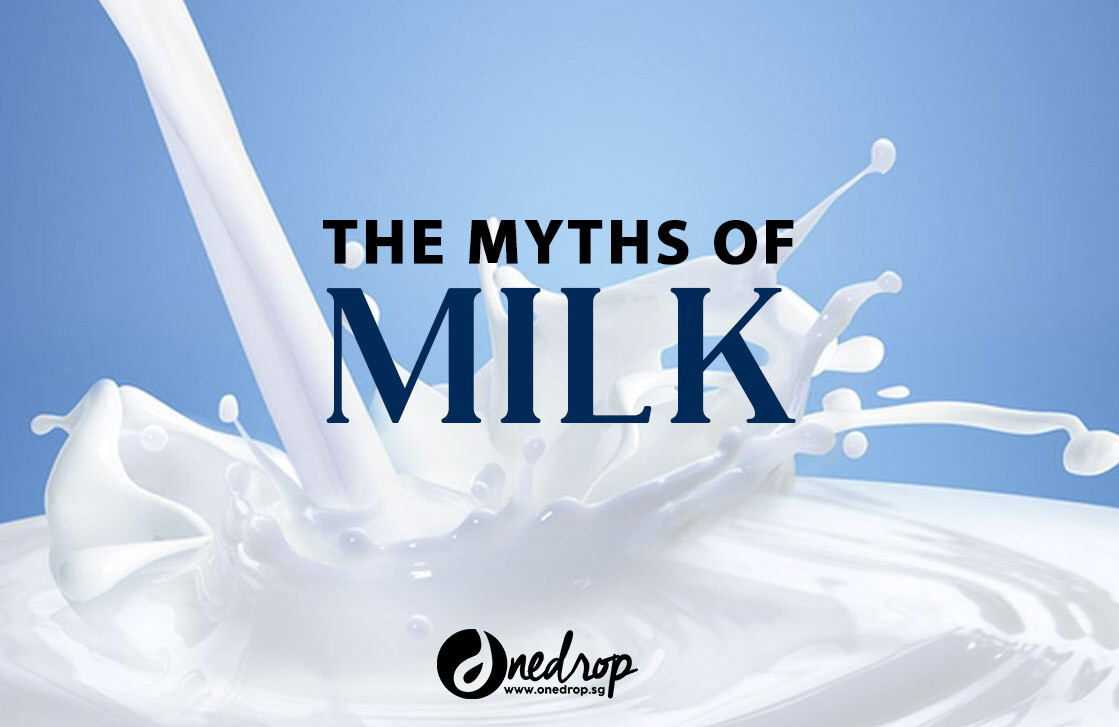
THE MYTHS OF MILK
This post is contributed by One Drop member –Eva Rosdiana.
For decades, we were told that milk is compulsory food in our diet. These statements and understandings have been rooted deeply in our society.
The high demand of milk has led to industrialization in dairy industry. Today, in the United States for instance, an estimated $4.5 billion is subsidizing and supporting the marketing campaigns by the dairy industry. That makes us, humans, as the only species of mammals that drinks another species’ milk after infancy.
My curiosity about milk started in 2011, when I read an article from Mike Geary, a dietician and nutritionist on “The Truth of Milk”. In 2013, I read a book from Dr Hiromi Shinya titled “The Enzyme Factor”. Dr Hiromi Shinya is a Japanese surgeon who is pioneer in colonoscopy and one of the leading gastroenterologists in the world. He wrote that based on his personal, clinical experiences and observations from over 300,000 colonoscopies, cow milk is harmful agent to humans.
The reason behind Lactose Intolerant
Lactose (milk sugar) is a two-chain carbohydrate that consists of one molecule Glucose and one molecule Galactose. Lactose is also present in human breastmilk. We need a digestive enzyme Lactase to break down Lactose into Glucose and Galactose. A lactose-intolerant person does not have sufficient Lactase to digest lactose. This causes the undigested lactase to go into our colon and fermented by bacteria. It then results into abdominal pain, bloating, gas, nausea, diarrhea, and any other discomfort within 30 minutes to 2-hours after consumption.
90% of Asians has insufficient Lactase
In general, the amount of Lactase in human reduces after the age of 3 years old. All humans in early civilizations become lactose intolerant after the weaning years. It was only during the invention of agriculture some thousands of years ago that allowed cultures in the Western hemisphere to eventually develop lactase persistence. Therefore, lactose intolerance rates among northern Europeans can go as low as 5% of adults while in some Asian communities, it can go as high as over 90% (See the map chart). [Source]
Fermentation
Fermented dairy products such as yogurt, kefir, cheese reduce the amount of lactose significantly. During fermentation process, lactose is broken down by the bacteria colony (mainly Lactobacillus) to form lactic acid and sometimes alcohol or carbon dioxide. Lactose-intolerant people can tolerate these products.
However, some fermented dairy products are either further processed or added with high amount of sugar. Even though some products labeled as “healthy products”, we should avoid sweetened yogurt and processed cheesebecause they may cause more harm to our body.
Milk and Casein Allergy
Milk contains protein, called Whey and Casein. Casein can also cause allergy, and usually it is called milk-allergy.
Casein allergy is different from Lactose intolerance. Lactose intolerance causes abdominal and digestive discomfort. Casein allergy can cause symptoms such as a skin rash or hives; swollen lips, mouth or tongue; nasal congestion, runny nose, watery/itchy eyes, and so on [source]. If you have casein allergy, you should avoid all dairy products including the fermented ones.
Casein and whey can cause an actual immune response and be considered a true allergy by promoting an IgE (Immunoglobulin E) response from the immune system. The response can cause inflammation. The number of people with milk allergies is estimated to be far below that of lactose intolerance [source].
The Bad and Worse
The milk that is sold in the supermarket has gone through a heavy process of homogenization and pasteurization. It results in milk oxidation and hydrogenation. Dr Shinya wrote that a calf that is given milk sold in the supermarket will die within 4-5 days. It is because that milk does not contain any living enzymes. He also observed that the cases of dermatitis atopic and allergy have been increasing significantly in the last 30 years. This is in line with the introduction of milk in Japanese school lunch menu since 1960. Pregnant women who consume milk as “source of calcium” also will increase the risk of dermatitis atopic in the babies.
Homogenization
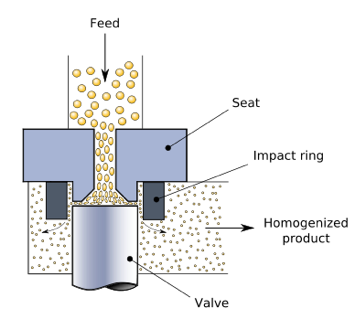

Homogenization is a process to give milk its rich, white color and smooth texture. The homogenization process involves reducing the size of the fat globules – the cream that rises to the top of the glass or bottle – into minuscule portions that are dispersed evenly throughout the milk. The purposes of homogenization are:
- to prevent separation of whey and curd (Image A)
- to prolong the shelf life.
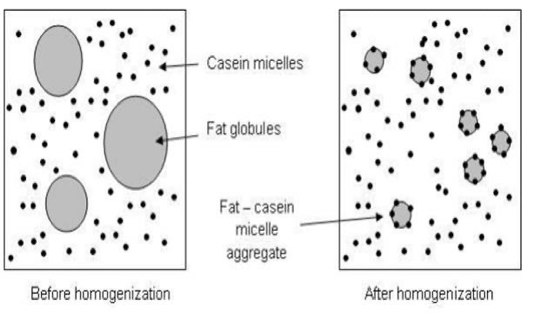
Disadvantages of homogenized milk:
- Free radicals resulting from oxidation and hydrogenation of fat globules
- Bondage with casein to form new aggregation due to smaller fat globules
- Globules get into bloodstream because not properly digested.
- Inflammation because the globules may enter arteries. It destroys our gut microbiome and hence bad bacteria increases in our gut.
[Source: Dr Kurt Oster; Dr Hiromi Shinya – The Enzyme Factor]
Pasteurization
The homogenized milk is brought for pasteurization. Pasteurization is the process of heating the milk at high temperature to eliminate bacteria and extend the shelf life of milk.
The most common pasteurization process in the market are [source]:

Disadvantages of pasteurization are:
- Denatured protein
- Damaged natural calcium – hence many manufacturers add synthetic calcium
- Elimination of living enzymes that are present in raw milk, including Lactase. Enzymes will get destroyed from 43°C.
- Elimination of vitamins (such as A, C, B6, B12)
Truth or False – Milk is the source of Calcium
The most common misconception is milk can prevent osteoporosis. This is based on a scientific statement that calcium in our body reduces as we age. As milk contains high amount of calcium, we are advised to consume milk to add calcium into our body. Can our body absorb milk calcium fully?
In normal situation, plasma calcium (Plasma Ca) level is 9-10mg. When we consume milk, calcium concentration increases significantly. But the bioavailability of calcium from dairy product is only 30% [source]. When Plasma Ca is too high, our body tries to bring it to normal level by disposing the excess calcium through our kidneys and coming outas urine. This will add burden into our kidneys.
Additionally, synthetic calcium that is mostly added in milk can be harder for our body to process.
Calcium Absorption
To fully absorb and use calcium, we need these 3 micro-nutrients:
- Magnesium (Mg) – Stimulate Calcitonin hormone in Thyroid gland to help Calcium deposit to bone (link). Minimum ratio Ca:Mg = 2:1 or less. Ratio Ca:Mg in milk is 4:1. Best sources of magnesium are raw leavy vegetables and raw cacao.
- Vitamin D3 – Absorbs Mg and Ca by 20x and helps to bring these minerals to blood. Pasteurized milk changes Vitamin D3 in raw milk to D2. Best source is from sunlight.
- Vitamin K2: Fat soluble vitamin. Primary function is to transport Calcium from joints and blood to bone. Good source: Natto.
Conclusion
Milk is one of the heaviest marketed products, also the second most hydrogenated products after cooking oil. After 2 years old, we do not need milk as source of nutrition.
Kids should get their nutrition from whole food after they are weaned off from breastmilk or after 2 years old if they are on formula milk. Growing-up milk and pregnancy milk are not necessary because they contain high amount of sugar and hydrogenated oil.
If you like the taste of dairy products, try to reduce the frequency and amount of consumption. It is not necessary to make it compulsory in the diet. We can always get the nutrients in milk from other whole food sources.
If you like Eva’s articles and would like to purchase the Young Living oils or have further clarifications, you may get in touch with Eva via Facebook or Instagram. If you are ready to sign up as member with Eva, you may click here.


